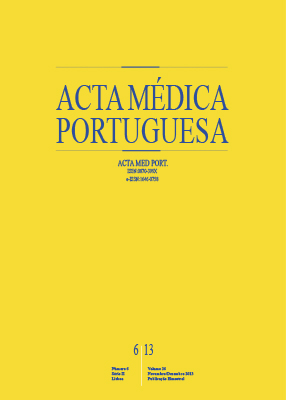Laparoscopic Surgery of Gastroesophageal Reflux in Children
DOI:
https://doi.org/10.20344/amp.2071Abstract
Introduction: Gastroeshophageal reflux is a common but usually innocuous condition in children. However, in the presence of Gastroeshophageal reflux disease, the surgical treatment (open or laparoscopic) may be indicated. This study aimed to evaluate the feasibility, effectiveness and safety of laparoscopic antireflux surgery (Nissen fundoplication) with emphasis in infants.
Material and Methods: Children with gastroeshophageal reflux proposed for laparoscopic antireflux surgery between January 2006 and December 2012 in a pediatric surgery department of a university hospital were studied. A descriptive and comparative analysis was conducted with regard to age (group I: <1 year, group II: 1-3 years, group III: > 3 years) and presence of comorbidities. Demographics, symptoms, comorbidities, operative indications, perioperative and postoperative outcome were assessed. The statistical significance level was set at 5%.
Results: 55 children were proposed for surgery: 12 of group I, 15 group of II and 28 of group III. 50.9% had comorbidities (21 central nervous system disease and 7 esophageal atresia). In 52 (94.5%) cases, antireflux surgery was performed by laparoscopy. The procedure lasted 167 ± 42 minutes, with no significant differences according to age groups, although higher in those with central nervous system disease. With a follow-up of 35.5 ± 23.9 months, the following complications occurred: gas-bloat syndrome, dumping or dysphagia in 8 cases (15.7%) and paraesophageal hernia in 2 cases (3.9%), with no significant differences between groups; there was clinical recurrence with reoperation in 2 cases.
Conclusion: Laparoscopic Nissen fundoplication is a feasible and effective procedure, with minimal morbidity, including in infancy.
Downloads
Downloads
Published
How to Cite
Issue
Section
License
All the articles published in the AMP are open access and comply with the requirements of funding agencies or academic institutions. The AMP is governed by the terms of the Creative Commons ‘Attribution – Non-Commercial Use - (CC-BY-NC)’ license, regarding the use by third parties.
It is the author’s responsibility to obtain approval for the reproduction of figures, tables, etc. from other publications.
Upon acceptance of an article for publication, the authors will be asked to complete the ICMJE “Copyright Liability and Copyright Sharing Statement “(http://www.actamedicaportuguesa.com/info/AMP-NormasPublicacao.pdf) and the “Declaration of Potential Conflicts of Interest” (http:// www.icmje.org/conflicts-of-interest). An e-mail will be sent to the corresponding author to acknowledge receipt of the manuscript.
After publication, the authors are authorised to make their articles available in repositories of their institutions of origin, as long as they always mention where they were published and according to the Creative Commons license.









